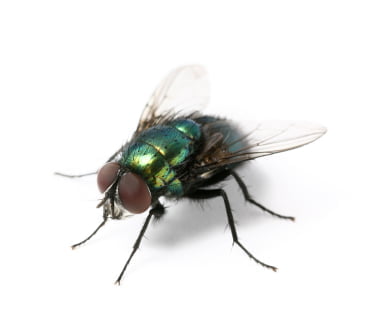Blow Flies: Blue or green bottle flies are robust flies with shiny metallic bodies that can often be found in homes during winter and early spring. These insects develop in manure or carrion and are usually apparent in small numbers. However, they are strong fliers and are attracted to lamps or lights. Their “buzzing” flight is very annoying.
Drain Flies often are a temporary problem. They develop in standing water so most commonly they are seen after returning home from a vacation or period of extended travel. Usually, they disappear soon after normal household activity resumes and water starts to move again through toilets and drain traps. The few adults resulting from these small infestations can be killed easily with a swatter or flying insect spray. However, finding many flies over several weeks usually means a relatively permanent breeding site that must be found and eliminated. Ending a chronic infestation can be challenging.
Face Flies are serious pests of cattle and may overwinter in homes or invade them during the summer. They closely resemble the common housefly, and only an expert can tell them apart. Overwintering face flies have habits similar to cluster flies and control procedures are similar. Face flies are most likely to invade farm homes or homes located near pastures or where cattle are kept since the larvae develop in fresh cattle manure. During the summer, the adults feed on the mucous secretions from the eyes and noses of cattle and horses.
Fruit Flies are common in homes, restaurants, supermarkets and wherever else food is allowed to rot and ferment. Adults are about 1/8 inch long and usually have red eyes. The front portion of the body is tan and the rear portion is black. Fruit flies lay their eggs near the surface of fermenting foods or other moist, organic materials. Upon emerging, the tiny larvae continue to feed near the surface of the fermenting mass. This surface-feeding characteristic of the larvae is significant in that damaged or over-ripened portions of fruits and vegetables can be cut away without having to discard the remainder for fear of retaining any developing larvae. The reproductive potential of fruit flies is enormous; given the opportunity, they will lay about 500 eggs. The entire lifecycle from egg to adult can be completed in about a week.
Fruit flies are especially attracted to ripened fruits and vegetables in the kitchen. But they also will breed in drains, garbage disposals, empty bottles and cans, trash containers, mops and cleaning rags. All that is needed for development is a moist film of fermenting material. Infestations can originate from over-ripened fruits or vegetables that were previously infested and brought into the home. The adults can also fly in from outside through inadequately screened windows and doors.
Fruit flies are primarily nuisance pests. However, they also have the potential to contaminate food with bacteria and other disease-producing organisms.

